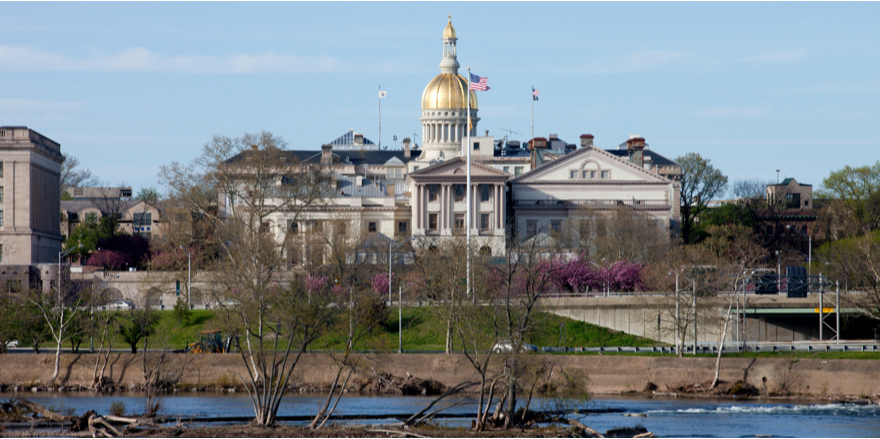The pandemic caused economic shocks that made waves in markets and reached every corner of our nation. Researchers at the Bank quickly pivoted to assess the impacts and reveal risks and vulnerabilities that can inform policymakers, regulators, and others as they make decisions that strengthen markets and communities.
State Budgets and the Long Road to Recovery

Adam Scavette analyzed state
budgets, looking to lessons from
the last recession.
As state and local governments across the U.S. braced for hardships due to the pandemic, Adam Scavette, a regional senior economic analyst, sought to assess the outlook for Third District states, looking to lessons from the last recession. “During the Great Recession, states’ budgets were under tremendous pressure, and they had to cut state and local employees and services,” said Adam. “The recovery, especially with respect to employment, took until right before the coronavirus recession.”
State budgets are unique, making them particularly vulnerable to economic downturns. Unlike the federal government, states have restrictions on how they can raise revenues, and most states must balance their budgets each year.
When Adam looked into the preparedness of Delaware, New Jersey, and Pennsylvania, he found that all three states’ rainy-day funds were below the U.S. median. In terms of investment ratings, Delaware was one of the highest-rated states, but Pennsylvania and New Jersey were among the worst rated. Moreover, New Jersey lagged behind the nation in a stress test model that estimated tax revenue shortfalls through fiscal 2021.

Adam notes that the previous recession may offer lessons learned on how the federal government can support states as they navigate the fallout of the pandemic. Although federal aid granted to states early in the pandemic relieves some pressure, it will not fill budget gaps. The $150 billion that states received through the CARES Act came with restrictions requiring it to be used only for expenditures related to the public health emergency. The Fed’s Municipal Liquidity Facility relieved interest rate stress for borrowers in the municipal bond market, but after calming markets, the program ended in 2020. “During the last recession, states had to cut state and local employees and services,” said Adam. “This probably affected the speed of the overall recovery for the U.S. economy."
COVID-19 and Risk in the Corporate Bond Market

Benjamin Lester studies risk in
markets to inform regulators
and policymakers.
Pre-COVID, Benjamin Lester, senior economic advisor and economist, was already studying whether regulations put in place after the 2008 crisis were making the corporate bond market less liquid. When the coronavirus pandemic hit and investors looked to sell assets like corporate bonds en masse, the shock gave Ben and his coauthors a real-life picture of how the market would react if there was a lot of selling pressure at the same time. “You could see very quickly that it wasn’t going well,” said Ben.
In particular, dealers appeared unwilling to “lean against the wind” and absorb assets onto their balance sheets. Corporate bonds don’t change hands very quickly to begin with, and before the pandemic, the amount of bonds held in the dealer sector as a whole had been going down, partly due to regulations enacted after the last crisis.
The Fed’s unprecedented interventions into this important market provided Ben and coauthors an opportunity to study what causes markets to falter and the types of interventions that can help. After announcing a variety of new facilities aimed at restoring liquidity in other key markets, including the Treasury market, on March 23 the Fed announced that, for the first time, it would begin buying investment-grade bonds.
Although the announcements looked like a turning point for the bond market, the coincidence of new policies and market improvements do not, by themselves, establish causality. Hence, Ben and his coauthors performed an analysis that looks at a change across two different groups — in this case, bonds that were eligible or ineligible for the Fed to purchase. They found that, immediately after the announcement, liquidity conditions improved significantly for bonds that were eligible to be purchased, but not for ineligible bonds, suggesting that Fed interventions improved trading conditions. However, Ben said the research left some big unanswered questions for further study around why these markets were so fragile and what regulators can do to make them more resilient in the future.
Travel Behavior During Coronavirus
While their colleagues were studying the economic impacts of the pandemic, Jeffrey Brinkman and Kyle Mangum, both senior economists, took a different angle: Analyzing cellphone data, Jeff and Kyle looked to understand how state and local government policies that sought to curb the spread of COVID-19 through stay-at-home orders, nonessential business closures, and limitations on mass gatherings affected travel patterns.

Their research found that overall travel declined significantly as the number of cases grew. What was surprising was that by comparing counties, they found that overall travel declined not just in response to government orders but also in response to the number of cases locally and the number of cases in nearby or connected counties.
“People were very sophisticated in the locations they were visiting, making decisions about where they were visiting according to the reported case counts,” said Jeff. “People in Philadelphia, for example, did not stop traveling completely, but they did stop traveling to New York following a spike in case counts early in the pandemic.
“You can create restrictions that dictate behavior or give people information,” Jeff explained. “It turns out that people will make rational decisions if they have the right information.”
Another key takeaway emphasized that because of spillovers across state lines, fragmented policies caused some confusion. “Having local policymakers coordinate with one another would have been beneficial,” said Kyle.

